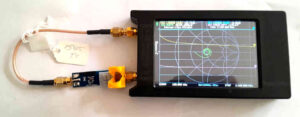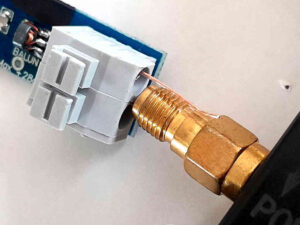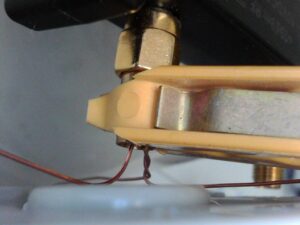Conversion of NOELEC style balun board to 1:1 left readers with a challenge to measure the through performance of the modified balun board.
The link grounding the centre tap was cut for this test to float the secondary so that one side could be grounded. This will give almost identical response to the case where the centre was grounded.
Above is the test configuration, the yellow thing is a top view of a modified plastic clothes peg which is used to clamp one of the wires from the transformer to the SMA threads.
Above is a close up view of the connection without the clothes peg in place, there would not be as much as 3mm of conductor between the grey block and the SMA connector. The wire is 0.5mm diameter single core copper stripped from LAN cable.
Test jigs do not need to be expensive to be effective.
Above, a view of the modified clothes peg from another article.
Above is a plot of |s21| to 150MHz. The compensation causes a self resonance at about 180MHz, so whilst improving its InsertionVSWR at lower frequencies, it limits its useful range to about 150MHz.
This plot would commonly be labelled a “loss” plot by hammy Sammy… you know, the guy who says the attenuation or loss in my coax is -2dB/100′.
So, to be clear, it is as labelled the magnitude of s21 expressed in dB and that is equivalent to InsertionLoss. See Measurement of various loss quantities with a VNA for further explanation.
So what is really interesting is to drill down on InsertionLoss.
Above is a plot of InsertionLoss and its components (Transmission) Loss and MismatchLoss.
(Transmission) Loss is due mainly to core loss and to a lesser extent some wire loss, and it results in conversion of electrical energy to heat.
Note that MismatchLoss is very low mid-band, and becomes greater at the lowest frequencies and at the high end. The low end is degraded by high magnetising admittance (too few turns for the frequency, core type). Again, compensation whilst improving the mid band does so at the expense of degrading high end performance. Nevertheless, the module is quite good for many purposes from 400kHz to 150MHz.




